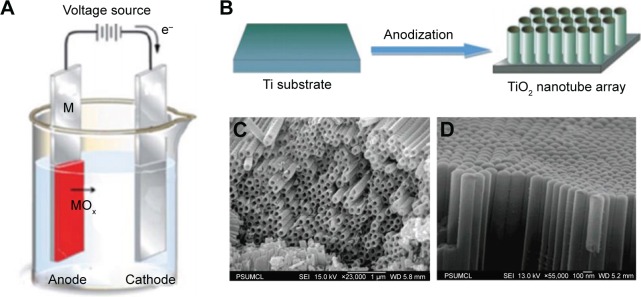Figure 1.
The formation and structure of TNTs.
Notes: (A) and (B) Electrochemical cell and anodization process for the formation of TNT layer on Ti substrate. SEM images of TNTs for (C) bottom and side surface and (D) top surface. (A) Reprinted Curr Opin Solid State Mater Sci, 11, Macak JM, Tsuchiya H, Ghicov A, et al, TiO2 nanotubes: self-organized electrochemical formation, properties and applications, 3–18,34 copyright 2007, with permission from Elsevier. (B) Reproduced from Ge MZ, Cao CY, Li SH, et al. In situ plasmonic Ag nanoparticle anchored TiO2 nanotube arrays as visible-light-driven photocatalysts for enhanced water splitting. Nanoscale. 2016;8:5226–5234,43 with permission of The Royal Society of Chemistry. (C, D) Reprinted with permission from Paulose M, Shankar K, Yoriya S, et al. Anodic growth of highly ordered TiO2 nanotube arrays to 134 μm in length. J Phys Chem B. 2006;110:16179–16184.20 Copyright 2006 American Chemical Society.
Abbreviations: SEM, scanning electron microscope; TNT, titania nanotube.

